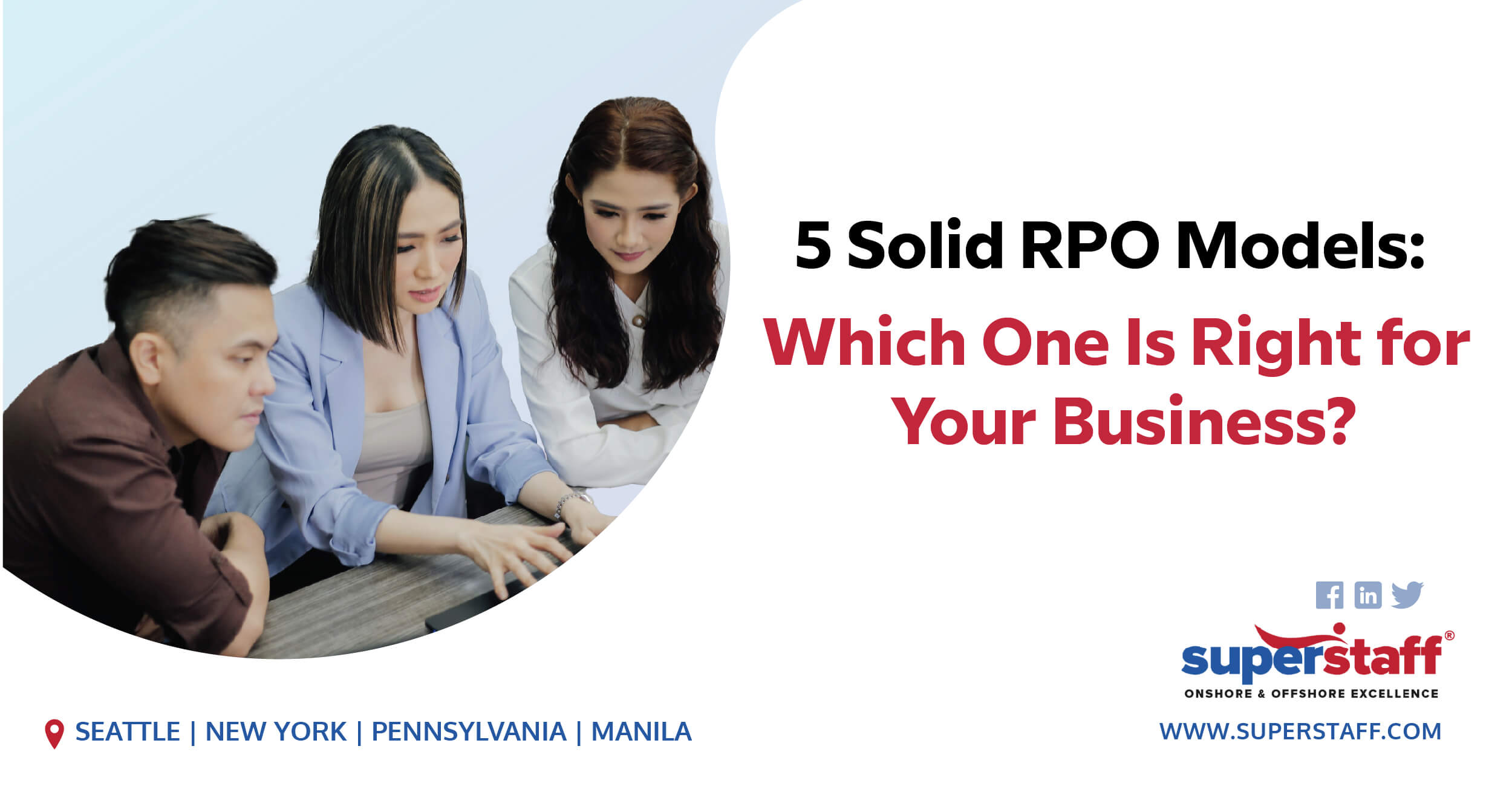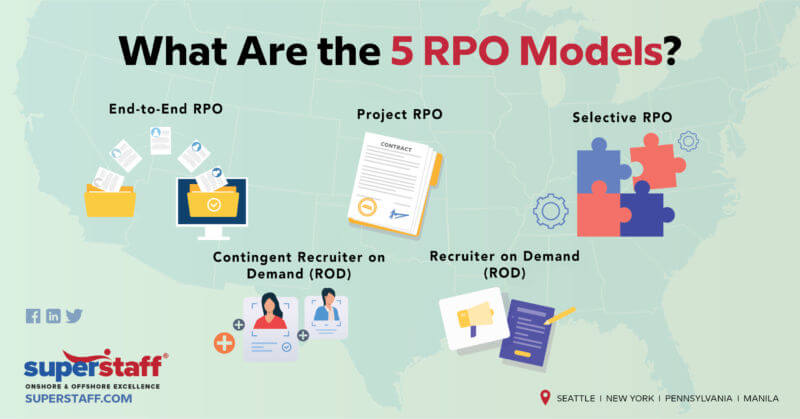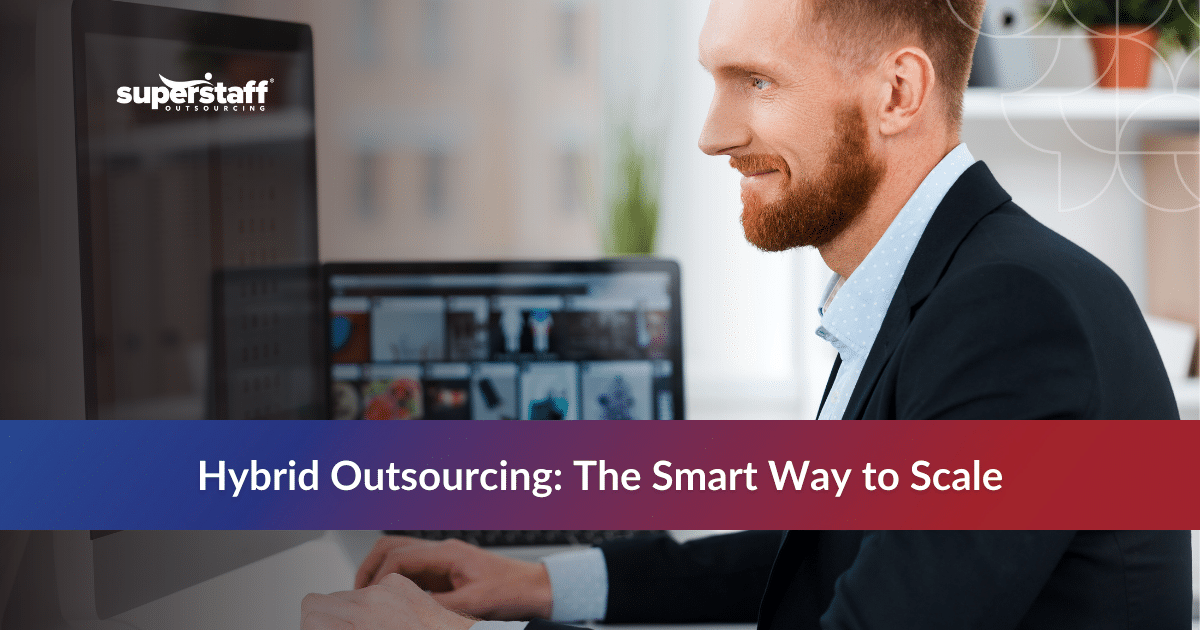
Talent acquisition remains one of the largest expenses of many businesses. On average, U.S. employers spend $4,000 per hire and between 24-40 days for recruitment alone. The amount and time frame do not include expenses for activities such as training, which costs an average of $1,286 per year. It is no surprise that more and more businesses are incorporating various RPO models into their systems to control expenses.
As businesses start to pump up their rehiring efforts since the pandemic, the global RPO market size is projected to reach $21.69 billion by 2027. That growth is significant compared to the recorded market size of $7.2282 billion in 2020 (CAGR of 17.0%).
If you consider employing RPO for your business, this article will help increase your concept knowledge. It serves as a valuable guide for determining which RPO business model suits you best.
What Is RPO?
Recruitment process outsourcing or RPO is a business model wherein a business assigns some or their entire recruitment functions to an external firm. This model has been proven to reduce expenses, speed up hiring time, increase candidate and employee engagement, and decrease attrition. RPO providers usually work remotely with operations onshore, offshore, or nearshore.
How Does an RPO Process Work?
Think of RPO as having an extension of your in-house recruitment team but with extra perks. When you work with a recruitment process outsourcing company, you get not only their services and expertise in talent recruitment. You also take advantage of their existing technology, methodologies, infrastructure, and other resources. As a result, you gain significant savings.
RPO engagements are also flexible. You can choose the specific RPO model that you need and customize it accordingly. This feature complements the ever-changing nature of business and fluctuating demands of recruitment.

Here Are the 5 Types of RPO Models:
#1: End-to-End RPO
With the end-to-end RPO model, all the processes involved in recruitment or talent acquisition are delegated to a third-party firm. The RPO service provider is responsible for the functions that impact the entire life-cycle of the candidate in the company. These functions usually include:
- Candidate Attraction
- Candidate Screening
- Candidate Assessments
- Interview
- On-Boarding
- Compliance Monitoring
- Exit Interviews
The end-to-end RPO business model is a long-term engagement that usually lasts at least a year. It is ideal for industries that require continuous hiring and businesses that have no expertise in talent acquisition. An end-to-end RPO service provider may also perform the project, on-demand, or contingency recruitment as needed.
#2: Project RPO
The project RPO model covers all the processes involved in the end-to-end RPO model but on a short-term basis, typically months. Usually, the business engages the RPO provider to handle the talent acquisition needed for a specific project. Once the project ends, the contract between the RPO provider and the company also ceases.
Some businesses that will best benefit from the project RPO engagement model are:
- Biopharma or medical manufacturing firms who are applying for an FDA approval
- Restaurants, boutiques, or any stores opening a new branch
- Corporation in need of additional bandwidth to complete a merger and acquisition deal or transition
Although the business and RPO provider relationship is tied to the project, this model is not usually a one-and-done deal. Some companies utilize project RPO as a testing ground to see if the contractor can meet their long-term needs.
#3: Selective RPO
Also known as limited or point-of-service RPO, the selective RPO model involves outsourcing only a select or specific recruitment function. This RPO engagement model helps prevent recruitment bottlenecks and ensures a smooth flow of the entire recruitment process. It is ideal for businesses with solid clout in specific recruitment tasks.
Some of the typical functions delegated to an RPO provider are:
- Candidate Sourcing
- Applicant Screening
- Candidate Management
- Matching
- Recruitment Marketing
An example of a business that employs the selective RPO model is the web domain and hosting company GoDaddy. At one point, they had a hard time filling engineer positions that could address the needs of their growing client base. They tapped an RPO provider to enhance their employee branding and recruitment marketing strategies. This move led to the fulfillment of their hiring goals.
#4: Recruiter on Demand (ROD)
This RPO engagement model is usually utilized for projects with shorter timelines. Recruiter on-demand offers businesses speed and flexibility.
Some of the services we use daily have the same principles employed by the recruitment on-demand model, such as Uber, GrabFood, and other logistics services. These providers are tapped as needed, and the engagement ends as soon as the service is delivered.
One example of a company that successfully benefitted from this RPO model is the e-learning company Bluedrop. At one point, they needed to implement AWS services to automate client service infrastructure. However, their existing hardware was not fast enough for the task. They tapped a third-party company to hire a principal DevOps engineer to develop a tool that helped accomplish their goal.
Another company that employed a recruiter on demand was construction equipment giant Caterpillar. They tapped an RPO provider to customize a flexible hiring strategy that suits their fluctuating recruitment demands. The strategy paid off and helped increase their hiring rates as needed.
#5: Contingent Recruiter on Demand (ROD)
Sometimes the need to fill specific positions becomes urgent. In these situations, businesses turn to contingent recruiters on demand. This RPO model is usually used to supplement the efforts of the company’s internal hiring team, mainly to increase speed.
In this setup, the RPO provider is not the only one working toward filling the open positions. They compete with the company’s internal hiring team, the direct applicants, or even another RPO provider. As such, the contractor only gets paid when they make a successful hire.
Companies usually contract contingent recruiters on demand for additional workforce following an unexpected surge in customer service inquiries. Recently, the need for contingent cybersecurity professionals also increased during Black Friday and Cyber Monday. This trend came after e-commerce businesses reported a surge in cybercrimes during these shopping holidays. In 2019, cyberattacks increased by 275% on Black Friday.
Since this RPO engagement model is fast-paced by nature, recruiters usually do not have the time to conduct the in-depth screening processes applied in other RPO models. This reason is why contingent recruiter on-demand is generally used for filling temporary and lower-level positions. For executive, senior, niche, and crucial roles, it is best to consider longer-term RPO business models to thoroughly assess the candidates’ qualifications.
Is the RPO Engagement Model Right for You?
Every business has distinct needs and challenges. To determine if recruitment process outsourcing is right for your business, you may refer to the scenarios below. If you meet any or all of the conditions mentioned, your next step should be to choose the RPO business model that suits your needs.
If You’re in a Specialized Industry and Requires Specific Expertise
Compared to other sectors, the labor market is tighter for specialized or niche industries. The comprehensive requirements and qualifications needed make it challenging to find the right talent to fit the roles. The talents’ caliber also makes the competition tougher.
RPO providers have creative hiring techniques under their sleeves. They know how to build effective and customized talent acquisition strategies. Since they continuously tap passive candidates, outsourced recruiters can position your business close to where the rare talents are in the fastest possible way. RPO can reduce the time to hire by 25-55%.
If Your Business Is Scaling
Apart from cost reduction, many enterprises choose to outsource recruitment processes to increase agility. It is the quickest way to expand teams and realize ROI. RPO enables you to customize the methods and allows you to respond to fluctuating hiring demand almost instantly.
If the Open Positions in Your Organization Are That of Contractors and Temporary
Sometimes, your staffing needs can spike on one season only to dip on the next. If this is normal in your line of business, it’s impractical to hire a full-time team since you will not likely maximize your investment. Engaging an RPO solutions provider can avoid the long-term costs associated with an in-house recruitment operation, such as benefits, training expenses, and insurance. As a result, you can realize 40-60% savings on operational costs.
How Much Does RPO Cost?
Cost is one of the primary considerations when deciding which RPO model suits your business best. However, there is no definite answer to the question “how much does RPO cost.”
The amount may vary depending on the number of hires, nature of the industry, timeline, and many other factors. As such, the RPO industry uses different pricing models that consider businesses’ flexible and varying needs.
Here are the common RPO pricing models. You may employ each model individually or combine one with another:
- Management Fee – In this model, the client and the RPO provider agree on a certain fee for a specific number of qualified candidates. The payment term is usually paid monthly, whether the candidates make it to the next stage or not, to cover the costs related to sourcing.
- Cost per Hire – As its name implies, this pricing model assigns a specific fee per successful hire. The fee is usually based on a certain percentage of the hire’s salary. The cost per hire is ideal for other short-term RPO business models.
- Cost per Slate – If cost per hire charges per successful hire, the cost per slate model charges per set of qualified candidates. The RPO provider has to meet a specific number of candidates then charge the business per set.
- Cost per Transaction – The RPO provider bills the business according to the functions or transactions completed in this model. For instance, the contractor and client may agree on an hourly, per volume, or per hire fee for outsourcing the initial assessment function. Cost per transaction is ideal for selective and project RPO engagement models.
How To Select the Right RPO Partner
RPO brings tremendous benefits to businesses of all sizes and across industries. But to make the most of the process, it is imperative to choose the right contractor. Take some time to assess the traits and capabilities of the provider before jumping into a decision. The following questions can help guide you through the process:
- Can the RPO provider address the challenges in your recruitment infrastructure?
- Do they have access to a large talent pool?
- Can they guide you into choosing a suitable RPO business model?
- Do they support the RPO model that your business requires?
- Are they capable of coming up with customized talent sourcing and acquisition strategies on demand?
- Are they capable of meeting your timeline?
- Do they offer scalable and flexible options?
- Do their values align with that of your company and your goals?
- Are they familiar with the requirements of your industry?
- Do they have a reputation for reducing their clients’ turnover rates? How are their own turnover rates?
- How do they intend to maintain constant communication with your hiring manager and other members of your internal team?
- Apart from recruitment, what other value-enhancing solutions can they bring to the table?
Make the Right Choice With SuperStaff
SuperStaff is here to help you make an informed decision and choose the ideal RPO model for your business. Schedule a consultation with one of our RPO specialists today!






